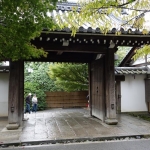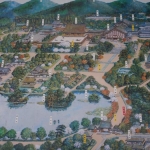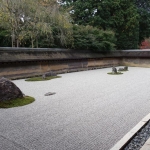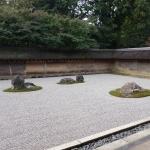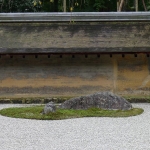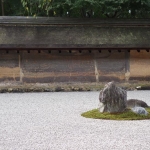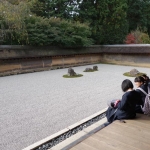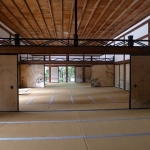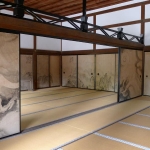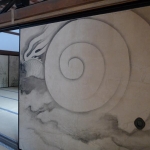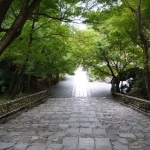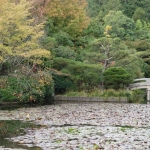Ryoan-ji
All night
autumn winds being heard
behind the mountains
–Bashō
The dry garden of Ryoan-ji (Dragon Peace Temple) was created as an aid to meditation.
The rock garden is believed to date from about 1500, its designer unknown. It is the supreme example of the the dry (kare-sansui) garden in which rocks and raked gravel together create this Zen garden.
It clearly demonstrates the Japanese attitude toward revealing essences through suggestion rather that by any concrete statement. The garden provides only one part, the mind the other.
Another important aspect of this garden is that the fifteen stones have been skillfully arranged so that one rock remains hidden when seen from any point along the veranda.
The grounds were originally the estate of a nobleman of the Fujiwara family in the Heian period, but later passed into the hands of the Hosokawa family. The famous general Kosokawa Katsumoto died during the Onin Wars (1467-14770, and according to his wishes the estate became a temple of the Rinzai sect of Zen Buddhism under the patronage of the nearby monastery, Myoshin-ji.
Ryōan-ji also has a teahouse and tea garden, dating to the 17th century. Near the teahouse is a famous stone water basin, with water continually flowing for ritual purification. This is the tsukubai which translates literally as “crouch;” because of the low height of the basin, the user must bend over to use it, in a sign of reverence and humility. The kanji written on the surface of the stone basin, 五, 隹, 止, 矢, are without significance when read alone. Though the water basin’s frame is circular, the opening in the circular face is itself a square (口). If each of the four kanji is read in combination with 口 (the square-shaped radical is pronounced kuchi, meaning “mouth” or “aperture”), which the square opening is meant to represent, then the characters become 吾, 唯, 足, 知. This is read as “ware, tada taru (wo) shiru“, which translates literally as “I only sufficiency know” or, more poetically, as “I know only satisfaction”. Intended to reinforce Buddhist teachings regarding humility and the abundance within one’s soul, the meaning is simple and clear: “one already has all one needs”. Meanwhile, the positioning of the tsukubai, lower than the veranda on which one stands to view it, compels one to bow respectfully (while listening to the endless trickle of replenishing water from the bamboo pipe) to fully appreciate its deeper philosophical significance. The tsukubai also embodies a subtle form of Zen teaching using ironic juxtaposition: while the shape mimics an ancient Chinese coin, the sentiment is the opposite of materialism. Thus, over many centuries, the tsukubai has also served as a humorous visual koan for countless monks residing at the temple, gently reminding them daily of their vow of poverty. Notwithstanding the exquisite kare sansui rock garden on the opposite side of the building, the less-photographed Ryōan-ji tea garden is one of the most sublime and valued cultural treasures the temple offers to the world.
I have experienced Ryoan-ji a few times, once with excited teenagers and others with just a very few people. Viewed only from a veranda, this garden can truly be appreciated in solitude.
Go first thing on a Monday morning and enjoy the quiet while it lasts. Plan to go early in the morning or late in the afternoon.


